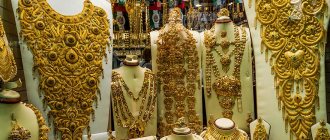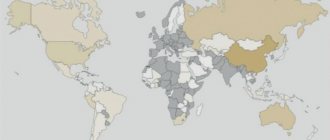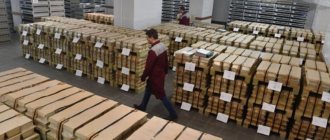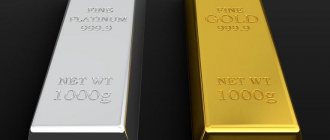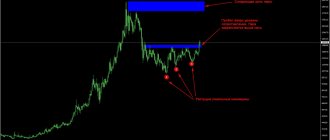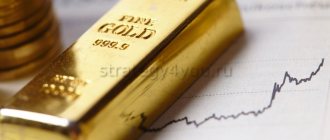There is a common myth among novice investors that the global gold market is one of the smallest commodity markets on a global scale. This assumption is based on the fact that annual gold production is relatively modest. However, the facts indicate the opposite: the volume of trading operations in gold far exceeds the volume of its production. How the gold market works, where this precious metal circulates on a global scale and who participates in the trading - this article will tell you about all this.
World gold market
is a collection of international and domestic markets around the world that trade physical gold and derivatives.
Gold market
is a trade and financial center for regular gold trading at market prices. Such centers are an association of large banks, precious metals exchanges and specialized organizations for gold trading, refining and production of bullion.
The global gold market operates around the clock, without stopping for a minute. The markets of the Far East and New Zealand open, then Sydney, Tokyo, Hong Kong, Singapore, etc. are connected according to time zones, and the day ends in New York. Currently, there are over 50 gold markets around the world (19 markets in Asia, 14 in America, 11 in Europe, 8 in Africa).
Gold, as a marketable commodity, comes in a variety of forms. Mostly standard ingots weighing 12.5 kg, fineness 995 or 999 with the mark of reputable refineries are traded on international markets. Domestic markets sell bars ranging from 5-10 g to 1 kg, as well as sheets, plates, disks, coins and even gold dust.
Trading gold has its own characteristics, unlike similar transactions with other precious metals. Settlements on international markets are carried out in US dollars per troy ounce of chemically pure metal in an ingot (for settlements with platinum, the alloy mass of the ingot is used). For delivery purposes, the unit is 1 ingot and the number of ingots in the delivery must have an integer expression.
Introduction
The price of physical gold is determined by the supply and demand for physical gold. The global physical market can be divided into exchange-based and two-way trading. Apart from the physical market, there are many gold derivatives markets that influence the physical market. To understand the whole machine, we will look at how gold exchanges, two-way trading (networks) and derivatives work individually and finally how all derivatives are tied to the physical market. Derivatives are traded on exchanges and bilaterally, but for the sake of clarity we will discuss them separately.
It is important to note that there is no single price for physical gold. Since gold is a commodity and the forces of supply and demand for commodities are not equal in any one place, and energy and time are required to transport commodities, the price of physical gold varies geographically. Moreover, physical gold comes in different shapes, weights, and purities. The cost of producing gold bars is more or less fixed, but is comparatively cheaper for larger size bars due to their higher cost.
What most people refer to as the spot price of gold is the price per troy ounce of pure gold obtained from the trading of large wholesale bullion located in London (“loco London”). Large wholesale bars weigh approximately 400 ounces. The smaller the bar compared to "big bars", the greater the premium to its price. Gold coins and jewelry have an even higher net weight premium due to even higher production costs. So the "real price of physical gold" depends on where you are and what commodity you are trading.
The net weight of a gold product is calculated as follows: net weight = gross weight * purity
.
Gold exchanges
An exchange is a centralized market. Any exchange can list multiple gold contracts. The Shanghai Gold Exchange, for example, trades spot gold contracts in sizes ranging from 100 to 12.5 kg. Supply and demand on the exchange are satisfied through the exchange's order book (exchange book). To put it simply, some market participants submit limit buy and sell orders on the order book, while others submit market orders (buy or sell). The matching engine connects and clears all orders, and this is how the price is set.
Below is a screenshot from the order book for the Shanghai Gold Exchange Au 99.99 contract during the overnight trading session on March 18, 2021. The bid and ask quotes are shown in red (top right corner); the corresponding yellow indicators reflect market depth (liquidity). The highest bid on this order book is 365.15 yuan per gram; the lowest price is 366 yuan. The market was illiquid during this trading session as the order book was very low.
Because the order book is visible to all traders and there is a central authority that sets trading rules, exchange trading is more transparent than two-sided trading networks called over-the-counter (OTC) markets. Some traders prefer exchange trading, others prefer over-the-counter trading, which offers greater flexibility and freedom of action.
Spot gold exchanges are rare. Examples are the Shanghai Gold Exchange in China, Borsa Istanbul in Turkey and the Dubai Gold and Commodities Exchange in the UAE.
Arbitrage causes prices to synchronize between different parts of the global gold market. When gold is cheaper in Dubai than in Shanghai, the arbitrator can make a risk-free profit. A classic example is that an arbitrageur fixes his profit by buying gold where it is cheap and physically transporting the precious metal to where it can be sold at a higher price. Whether a transaction is profitable depends not only on the spread of prices, but also on the costs of financing (interest), delivery, insurance and, possibly, processing of the bullion. Alternatively, an arbitrageur could take a long position on one exchange and a short position on another until the spread closes and close out his positions.
Gold typically sells at a discount in net exporting countries such as South Africa compared to a premium in net importing countries. Gold trading centers such as the UK can shift from being a net importer to a net exporter, causing the local price to trade at a premium or discount to parts of the world that are on the other side of the trade (usually Asia).
The table on the right shows gold bullion standards around the world. Some of the listed exchanges are derivatives.
Precious metal exchanges
This sector of the global gold market is represented by specialized platforms and segments of large exchanges. This is where gold acts as a regular asset that is constantly bought and sold through exchange transactions. Electronic purchase and sale of the main currency of our civilization allows you to quickly make a profit even on a slight difference in price when working with large lots. And during periods of economic crises, gold on the stock exchange instantly takes a “long position”, acquiring the status of the most reliable long-term asset.
Users from different countries can conclude contracts for precious metals remotely. Therefore, this market is rightfully considered the most active segment of the international trade in gold, platinum and silver.
Bilateral trade
We previously discussed that there are only a few physical gold exchanges in the world. The implication is that most physical gold trading occurs on a two-way basis: negotiations are conducted on a principal-to-principal basis, whether through an electronic trading system, over the phone, or in person.
Because gold does not deteriorate and has been valued for thousands of years, all the gold that has ever been mined is still with us. This makes gold trading more like a currency exchange than a commodity in terms of supply and demand dynamics. Physical supply and demand is not limited to annual mine production and newly produced products.
Every day, gold is traded bilaterally between thousands of companies - refineries, banks, dealers, mints, miners, jewelers, industrial manufacturers, investment funds, etc. - and possibly millions of people around the world. Gold can be exchanged in any form, and of course can be changed in shape, weight and purity throughout the supply chain.
At its lowest level, two-way trade could be a Turkish woman selling a gold bracelet to her male neighbor. By agreeing with her proposed price, the neighbor influences the world price of gold, although extremely insignificantly. After all, if the neighbor rejects the woman’s offer, she will sell the bracelet to a jewelry store that is connected to the world gold market, where the supply will increase. Accepting her offer does not result in an increase in supply. This example shows that in every (two-way) trade, the buyer and seller influence the price of gold.
Trading between businesses in a two-way trading network is called an over-the-counter market. Globally, the London Bullion Market, controlled by the London Bullion Market Association (LBMA), is the most dominant over-the-counter gold market. Another active over-the-counter market is in Switzerland, the gold refining capital of the world. Every year, hundreds to thousands of tons of gold are transported to Switzerland, where 400oz bars destined for London, 1kg bars destined for Asia, 100oz bars destined for New York, or other bars and products are produced depending from need. Switzerland also has many large vaults for gold investors.
The London bullion market has a unique structure in that it is based on two-way trading but is centralized. We will discuss this market in the next chapter on derivatives because most transactions in London are carried out through 'paper contracts'.
Types of markets
Depending on the range of participants, the volume of transactions, types of operations and the degree of openness, it is customary to distinguish the following types of gold markets.
International
These markets are characterized by large transactions and a wide range of operations, as well as the absence of tax and customs barriers. Operations are carried out around the clock and are wholesale in nature. As a rule, such markets have a relatively small number of participants, because The bar for the reputation and financial condition of the participant is quite high. The rules of the market are established by the market participants themselves. International markets include: Zurich, London, New York, Chicago, Hong Kong, Dubai.
Domestic
Domestic markets are aimed at investors and hoarders of one or more states. Coins and small bars predominate as goods; payments are made in local currency. Such markets are subject to government regulation through, as a rule, economic levers of influence: state participation in pricing, taxation, restrictions on the import and export of precious metals, etc.
Depending on the degree of government intervention, domestic markets can be divided into the following types:
- Free - with soft government regulation that does not limit the import and export of gold from the country.
- Regulated - with moderate government intervention through the establishment of import and export quotas, the introduction of duties and taxes, and licensing.
- Closed - strict control and a complete ban on the import and export of gold. The state creates unfavorable economic conditions for trading in precious metals; prices for precious metals become significantly higher than prices on international markets.
Domestic markets include: Paris, Hamburg, Frankfurt am Main, Amsterdam, Vienna, Milan, Istanbul, Rio de Janeiro. Regulated (controlled) markets operate in Athens and Cairo.
Black
“Black” gold markets are a radical form of organization of the domestic market, as a reaction to total restrictions (intervention) of the state on the domestic gold market. Illegal markets, as a rule, operate in parallel with closed ones. There are such markets in India and Pakistan.
We recommend reading: Investment attractiveness of gold
Derivatives markets
A derivative is a type of financial contract whose value depends on the underlying asset. In this article, we discuss financial derivatives that are based on physical gold. The single most important difference between physical gold and a gold derivative is that owning physical gold does not carry any counterparty risk, while owning a gold derivative does. For other commodities, such as corn, one might say, “you can eat corn, but you can't eat corn derivatives.” This comes down to the same economic conclusion: physical supply cannot be increased by creating derivatives.
However, derivatives have a significant impact on the price of physical gold because they are traded in large volumes and many use leverage. In my opinion, the most relevant derivatives markets are the equity market in London, exchange-traded funds and the futures market in New York.
Gold market participants
Gold mining companies, central banks, and private owners act as sellers in the market. Buyers include industrialists, jewelers, private investors, speculators, and in recent years central banks have returned. The following groups of participants in the gold market can be distinguished:
- Gold mining companies This is an important category of market participants, supplying the bulk of gold to the market. The larger the company, the larger the transactions that occur in the market with its participation. The giants of the gold mining industry can make a trade that is sufficient to instantly change the market price, so other market participants closely monitor their activities.
- Industrial consumers This group includes industrial enterprises, jewelry production, and refining enterprises.
- Precious metals exchanges The gold exchange trading market is represented by both individual precious metals exchanges and sections on large commodity exchanges. The presence of an exchange in the market as an intermediary allows an almost unlimited number of sellers and buyers to participate in trading.
- Central banks Central banks have a dual role in the market. They act as large operators that have a significant impact on market conditions. On the other hand, they are organizers who establish the rules of trading in the market.
- Professional dealers and intermediaries This group includes: commercial banks; companies trading precious metals; organizations involved in metal purification and refining; specialized companies providing intermediary services. Dealers play an important role in the market because... Most of the precious metal is initially concentrated in their hands.
- Investors are a broad category with an interest in a variety of investment instruments in the precious metal.
LBMA Integrity Supply Chain and London Bullion Market
The London Bullion Market is an over-the-counter market, so there is no set of rules like there is on a stock exchange. However, this unique market is somewhat organized. Let's start with the basics.
There are 71 LBMA accredited gold refineries around the world, which are the guardians of the LBMA chain. These refineries strictly accept gold from reputable sources, and when the gold supplied is bottled into 350 to 430 troy ounce bars that are at least 995/1000 pure, they adhere to LBMA (Good Delivery) sourcing standards. A complete supply chain is a closed system of gold refineries, reliable logistics companies and custodians who ensure that all precious metal in the chain is of the required quality. Bullion removed from the LBMA chain can only be re-entered into the market through accredited gold refineries.
LBMA member secure logistics companies can transport large bullion to vaults located within the M25 ring road in London. When gold bullion is stored in London vaults, it complies with the London Good Delivery standard and supports trading on the London Bullion Market. Although gold is located in London, traders from all over the world participate in the London Bullion Market.
Please note that the London storage system should not be confused with the LBMA's entire supply chain. The supply chain spans the globe and also includes various weights of bars from LBMA Good Delivery.
Gold bars produced in LBMA accredited refineries are the global standard. The Shanghai Gold Exchange (SGE), for example, accepts gold bars from SGE-certified refineries into its vaults next to LBMA-certified metal.
AURUM and global over-the-counter trading
At the heart of the London Bullion Market is an electronic clearing system called AURUM, which connects LBMA member clearing banks. The London bullion market can be thought of as a gold banking system, with physical gold held in London as reserves and AURUM as the depository and distribution system.
Gold trading in London is primarily carried out on an unallocated spot basis. An unallocated account at a market maker bank is a claim on a pool of physical gold owned by the bank. The retained balance can be compared to a fiat deposit in a regular bank. The unallocated balance is a loan to the London Bullion Market.
In contrast, through a distributed bank account, the customer owns uniquely identifiable bullion that is set aside and not on the bank's balance sheet. Customers pay to store allocated precious metal compared to the much lower cost, if any, of storing unallocated precious metal. Any client is allowed to switch from an unallocated account to an allocated account and vice versa, which links the paper market with the physical market in London. The market maker banks agreed that any fee for "placement" of the metal could only be changed upon 30 days' notice.
The main reasons why most trading on the London Bullion Market is carried out on a retained basis is convenience and efficiency. What makes gold special is that it is both a commodity and a currency. Retained trading allows you, for example, to buy exactly $1,000,000 worth of gold or borrow exactly 25,000 ounces. The designated trade size is always tied to different bar weights, resulting in awkward numbers. This is why "loco London unallocated" is used as the primary currency in the global over-the-counter gold market.
Clearing through AURUM is controlled and managed by London Precious Metals Clearing Limited (LPMCL). Clearing banks participating in AURUM (members of LPMCL) are HSBC, ICBC Standard Bank, JP Morgan and UBS. Other banks and participants in the London Bullion Market are associated in one way or another with the clearing banks.
Clearing banks either have their own vault in London, have accounts with custodians such as Brinks or Loomis, or use a Bank of England vault.
To the right is an illustration of the trading structure of the London Bullion Market. Clearing banks are connected through AURUM, and client banks and sub-clients are connected to clearing banks. All clearing banks, but not all client banks and subclients, are included in this illustration. All connections between corporations are hypothetical.
So how does trading actually work? Let's say a gold mining company borrows 180,000 ounces of unallocated currency at 2% from the bank in London where it has an account. This is UBS bank, which is the clearing bank. After receiving the loan, the gold miner sells the precious metal at the spot price to use the proceeds for a mining project in Australia. A year later, the company has produced 183,600 ounces and wants to pay UBS the principal plus interest (provided the interest is paid in gold). A gold miner transports unrefined gold to a refinery in Australia and indicates that he wants to be paid in the form of unrefined gold in London. The refinery accepts the gold and instructs its bank in London, Merrill Lynch, to transfer 183,600 ounces from its own account to the miner's account at UBS. Merrill Lynch will inform its clearing bank JP Morgan of the transfer of 183,600 ounces to the gold mining company's account at UBS. When UBS receives the unallocated amount through AURUM, 183,600 ounces will be debited from the gold miner's account and the loan will be repaid.
Australia sets the cash cost of gold refining and adjusts for the local gold discount/premium compared to the London price.
If any physical gold is transferred between JP Morgan and UBS via AURUM, it is subject to all transactions between these banks and their clients. The London Bullion Market hosts thousands of backlog trades every day, resulting in clearing banks making many claims on each other at the end of each day. The clearing process begins each day at 16:00 GMT, when LPMCL members “network” all claims. After this, the remaining claims are paid in physical gold.
Another example of how gold is exchanged on the London OTC market is with companies, central banks and investors trading gold just like any other currency on the foreign exchange markets. On a spot basis, as well as through forwards, swaps, options and leasing.
Gold trading centers
The main flow of transactions with gold bullion passes through the markets in London and Zurich. London initially held a leading position trading South African gold throughout Europe. In the late 60s, the leading position in the market passed to Zurich: South Africa established direct contacts with banks and began supplying up to 80% of gold production to the market in Switzerland. The year 1975 was significant with the lifting of the ban on gold trading in the United States, which allowed the gold markets in New York and Chicago to enter the world stage.
London
The origins of the gold market in London can be traced back to 1671, when the young merchant Moses Mocata arrived in London from Amsterdam with the aim of organizing trade relations with a London jeweler and banker. Initially, Mocata made money from sugar and diamonds, and the gold he brought was used to pay for precious stones. Soon deliveries of gold and silver to England became regular.
In accordance with the Exchange Control Act, for a long time the London gold market was open only to non-residents; the population of England did not have the right to transact in gold. Professional dealers were obliged to obtain a license from the Bank of England to carry out transactions in precious metals. It was only in 1979 that the state gave residents the right to buy gold, but by then markets in Switzerland and the United States were already thriving with a wide range of transactions in precious metals and derivatives.
The modern London market is the main center for over-the-counter trading of gold and silver bullion. The market is coordinated by the London Bullion Market
), organized in 1987. LBMA members include major international banks, manufacturers, processors and distributors around the world. It is in London that gold prices have been fixed twice a day since 1919, and silver prices have been fixed since 1897.
Unlike the futures exchange, the over-the-counter gold market provides some flexibility and privacy in transactions. Transactions are wholesale in nature, with a minimum transaction size typically of 1,000 troy ounces for gold and 50,000 ounces for silver transactions. More than 600 tons of gold and 3,000 tons of silver are traded daily.
We recommend reading: Buying gold: restrictions of the National Bank of Ukraine and new alternatives
A record volume of transactions in gold was recorded in March 1968. - 14180400 ounces in London Good Delivery bars, which is associated with the collapse of the gold pool.
Zurich
For a long time, Zurich traded gold from the London market, but in 1968 the role of the Swiss market increased dramatically. At this time, the London market was not functioning due to the introduction of a double gold market. Swiss banks took advantage of the situation to establish direct relations with South Africa, where gold production reached a historical maximum during that period. In addition, the second largest gold-producing country, the former Soviet Union, chose Zurich banks to sell the mined gold. Thus, Switzerland had two of the largest suppliers of gold, which was reflected in the annual turnover - more than 1000 tons of the precious metal.
Switzerland's traditional neutrality and currency stability strengthened Zurich's position as a global gold trading center. In the 1980s, almost 50% of the world's industrial demand for gold passed through it. Among other things, a significant advantage came from the peculiarities of the organization of the Zurich market: the largest universal banks were united in a pool, providing all kinds of services and operations.
Unlike London, where the majority of market participants are brokers, in the Zurich market banks act as dealers. Members of the pool conduct transactions with precious metals at their own expense and receive not commissions, but profits from the difference in price. It turns out that it is easier and more profitable for suppliers to work directly with Swiss pool participants than through an intermediary.
In the late 1980s, the active development of the over-the-counter or “behind-the-counter” market began, which was focused on meeting the interests of a specific client. This market is characterized by a lack of transparency; the client is not limited to any transaction size as on the stock exchange. The over-the-counter market includes central banks, gold mining companies, and hedge funds. Most transactions are hedged through the exchange, so the markets not only compete, but also complement each other.
The advantage of Swiss banks is due to their presence in global gold markets around the world, which guarantees a 24/7 presence in the international gold market.
USA
The lifting of the 40-year gold ban in the United States, which prohibited private ownership of gold bullion, has led to rapid growth in American gold markets. Commodity Exchange in New York ( COMEX, Commodity Exchange
), the Chicago Mercantile Exchange (
CME, Chicago Mercantile Exchange
) and the International Monetary Market (
IMM, International Money Market
) have become the largest centers for futures trading in gold. 90% of gold futures contracts are concluded in this segment of the market.
In conjunction with the exchange market, there is a gold bullion market in New York, from where gold is sent to industrial and commercial companies through wholesale dealers. Leading American banks (JP Morgan Bank, J. Aron & Company) act as market makers not only in the American but also in the international market.
A feature of the US markets is the predominantly venture nature of transactions (forward and futures transactions for a period of 1 to 6 months). The contract amount is strictly set at 100 ounces.
Singapore
As part of the implementation of the strategic plan for the formation of a global financial center, the gold market in Singapore was opened in 1969. Gold was sold from the Singapore market to Southeast Asia, Indonesia, Thailand, Vietnam, India, and Pakistan. In the 1990s, Singapore's annual imports amounted to 300-400 tons of gold, but declined towards the end of the 2000s. Own consumption of gold has a small share; the main demand came from jewelers in Indonesia, Thailand and Malaysia.
Singapore is one of the youngest and most quickly formed markets, but it has not managed to become one of the leaders in the world gold market. Currently, Singapore plans to enter the global market and increase its share of world trade by 7 times (from 2% to 10-15%) in the next five to ten years. On the way to the intended goal, the authorities abolished the taxation of all transactions with gold and silver. But the market will still have to beat regional competitors like Hong Kong and Dubai.
We recommend reading: Which gold is better to buy?
Türkiye
For a long time, the Turkish market was a significant regional gold trading center, supplying both local jewelers and delivering bullion to neighbors. In 1998, Turkey's position in the world market was strengthened as a result of the complete liberalization of trade in precious metals and the opening of the gold exchange in Istanbul.
The exchange has 50 authorized members, including banks and companies working with precious metals. According to Turkish law, only exchange members have the right to import and export precious metals. About 200 tons of gold are traded on the Istanbul Gold Exchange per year.
The lion's share of trade in gold and jewelry takes place at the “gold market,” located in a closed area with hundreds of jewelry shops.
Dubai
A large regional gold market in Dubai emerged in the early 60s. A port in the Persian Gulf and a large commodity market favorably influenced the development of trade in gold and silver. The growth in imports was aimed at meeting the increasing demand from India from year to year. After delicensing in 1997, Indian banks entered global markets bypassing the Dubai market, which reduced its importance and position.
Today, Dubai is the largest gold market in the Middle East and is dynamically developing as a center of global trade. Among the countries of the Middle East, the United Arab Emirates (UAE) ranks second in terms of its own demand for gold. In terms of gold imports on the world market, the UAE ranks second after India.
Hong Kong
Hong Kong returned to China in 1997 and remained a major gold market for a long time. In fact, during the life of the British Empire, the world's first gold and silver exchange was created in Hong Kong. Strict exchange controls limited transactions with gold to 945 tons of metal per year, which gave rise to smuggling from the neighboring Portuguese colony of Macau.
The liberalization of the gold market in 1974 resulted in the development and strengthening of Hong Kong's position in the world market. A local market was opened in London, which worked in parallel with the Hong Kong one and carried out arbitrage transactions. International banks acted as suppliers of precious metals, which were re-exported to China, India, Thailand, and Vietnam. Hong Kong's position in the gold market has declined markedly, with the bulk of gold passing through Hong Kong reflecting imports into China.
In May 2011, the Hong Kong Mercantile Exchange ( HKMEx, The Hong Kong Mercantile Exchange
) launched gold trading with physical delivery in Hong Kong. The contract is denominated in US dollars, the minimum transaction volume is 1 kg of gold. Transactions on gold futures on the exchange are carried out electronically 15 hours a day, which allows them to overlap with trading in London and New York.
LBMA Gold Benchmark Price
Trading on the London Bullion Market is carried out between all members of the LBMA. But with so many participants, you may be wondering what is the spot price of gold in this market? Technically, there is no single price for gold in this trading network.
The core of this market is made up of 12 LBMA market participants who are required to quote the two-sided market (ask and ask) throughout the day. These quotes are only available to legal entities who have an account with these banks. The spot gold price you see on Bloomberg, Reuters or Netdania, for example, is often an amalgamation of multiple data points from LMBA market makers. As a result, prices in these media may vary slightly.
This brings us to another feature of the London bullion market: the LBMA gold price benchmark. Formerly called the London Fix, the LBMA Gold Price auction is held twice daily at 10:30 a.m. and 3:00 p.m. This price is used for various purposes in the global market, such as industrial contracts.
LBMA Gold Price has 16 registered direct participants, each of which can provide auction access to clients. The auction begins with the announcement of the starting price. Based on the starting price, direct participants and clients indicate whether they are buyers or sellers and in what quantity (loco London unallocated). Typically, after the first round, the buying and selling volumes of all participants are not in balance, and the price is adjusted up or down, followed by a new round of trading. The process is repeated until the net volumes of all participants fall within a predetermined tolerance. Finally, the precious metal is calculated and the auction price is published.
The above is a simplification of the London bullion market. For more information, please refer to the LBMA OTC Guide and visit the LBMA website.
Where does gold come from in the markets?
Physical gold enters international markets from existing mines located in more than 50 countries around the world. Newly developed fields can also act as a source of proposals.
The leading countries in the production of precious metal in recent years are:
- China;
- Australia;
- Russia;
- USA;
- Canada;
- Peru;
- Indonesia;
- SOUTH AFRICA;
- Mexico;
- Ghana.
Currently, more than 3,000 tons of gold are mined in the world per year. According to the United States Geological Survey (USGS), global reserves of the metal amount to 54,000 tons. At current production rates they will be exhausted in about 17 years. At the same time, 54,000 tons is an estimated volume; tested and confirmed reserves are 15,000 tons.
Exchange traded funds
Exchange traded funds (ETFs) are funds backed by commodities, stocks, derivatives or other financial assets. ETF shares are traded on a stock exchange. Typically, gold ETFs are backed by physical gold. The largest gold ETF is GLD with a current holding of approximately 1,000 tonnes of London Good Delivery bars. Buying a share of GLD does not mean owning physical gold, but an ownership interest in the fund. Investors prefer to invest in ETFs because they are regulated financial products and are easily available through brokers.
One share of GLD is equal to approximately 0.1 ounces of gold. This amount decreases over time as storage fees are deducted from the assets (gold) held by the fund.
The price of GLD is tied to the physical market because a select group of arbitrageurs, called Authorized Participants (AP), can create and purchase shares of GLD from the Trustee of the BNY Mellon Asset Servicing Fund. If, due to supply and demand for GLD shares, the price of GLD falls below the spot price in London, APs may purchase shares of GLD and redeem them from the Trustee for physical metal, which they can sell at a profit on the spot market. Consequently, GLD stocks will decrease. If the price of GLD rises above the London spot, the APs do the opposite: they buy the spot metal and create shares of GLD to sell on the stock market. When creating shares, APs must deposit gold into a designated Trustee account (“All Trust gold is fully distributed at the end of each business day”). As a result, GLD stocks increase.
Through arbitrage, GLD and the physical market interact and influence each other.
What is this connected with?
It is difficult to say whether this gold then remains in the UK or is sent to other end-use countries, John Mulligan, director of the World Gold Council (WGC) for interaction with council members and markets, told RBC. But such large inflows, such as in this case from Russia, often indicate increased demand for gold from institutional investors both in the UK and abroad, he points out. “London is the center of global gold trading and the location where gold inventories are physically held to support many international ETF (exchange-traded fund) products, particularly gold ETFs (not just London-listed),” Mulligan points out.
In its 2021 report, the WGC noted that UK-based funds purchased $4.1 billion in gold amid concerns about Brexit (Britain officially left the European Union at the end of January 2021). Brexit has likely fueled investor interest in London-traded gold-backed ETFs, says RBC Mulligan. But overall, the scale of gold flows into the UK likely reflects global trends in demand for the precious metal and the country's traditional role as a center for its trade and storage, he said.
Brexit, of course, could have an impact on British investors, but there were “many other uncertainties,” including trade wars between the United States and China, notes NES finance professor Oleg Shibanov. But Brexit was known much earlier, he recalls.
Futures market
A futures contract is an agreement between two parties to exchange a commodity (or stock index, bond, etc.) for cash at a certain price on a certain date in the future. Although most commodity futures contracts never reach physical delivery, most are “rolled over” or terminated before expiration. Futures contracts involve leverage and are used by hedgers and speculators.
Futures trade many months in advance, but in this article we will focus on the “near month” contract, which covers the majority of trading volume. In what follows, I will simply refer to the price of the next month's contract as the futures price.
The most traded gold futures contract is GC, which is listed on the COMEX futures exchange in New York. Like GLD, gold futures interact with the spot market through arbitrage. Since London is the most liquid spot market, this is where most arbitrageurs will trade against New York.
Let's say the futures price exceeds London spot to such an extent that arbitrageurs can make a profit by buying spot and selling short futures. Of course, arbitragers can distribute the precious metal in London, convert the large bars into 100oz bars, ship them to New York, and physically deliver the futures contract at expiration. However, in reality this rarely happens. Unless, for example, there is a pandemic that disrupts global flights, arbitrageurs will go long in London and sell short futures in New York, wait for both markets to converge, and close their positions. Needless to say, when the spot price is higher than the futures price, arbitrageurs will do the opposite: cover the short position in London and buy long futures.
The futures market is also linked to the physical market through arbitrage.
